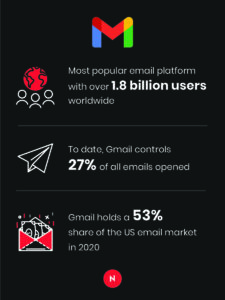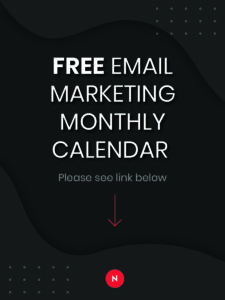Sep. 2, 2021

How to Make People Engage with Your Emails [+Free Email Calendar Template]
Emails are part of any successful digital marketing strategy.
Considered the marketing channel that generates the highest ROI for marketers for consecutive years, email marketing has become a crucial tool for effective content sharing and audience education.
But what are the key components to generate email engagement? Well, before thinking of a sophisticated approach, let’s get back to the basics and do it right.
Regardless of what you have in mind in terms of content for your next email marketing campaign, the ultimate goal is to get people to read.
There are 3 key components that can expedite your efforts when it comes to email engagement: Frequency, Personalization and Segmentation.
Together, they drive overall email marketing performance, impacting email deliverability, open rates, clicks and, more importantly, conversions.
That said, let’s dive into the three ways that I just mentioned to make people engage with your emails.
Frequency
In order to have people engaging with your emails, you need to send emails more often.
Unlike what many people think, increasing the frequency of outgoing emails increases your chances that your emails will be opened.
Bear in mind that, for various reasons, your subscribers may not open some of your emails, therefore, dramatically reducing your chance of success if you are sending just a few emails once and while.
Maybe you’ve sent some emails at the wrong time or on a day of the week that your subscribers don’t normally check their emails periodically. You should also consider that your emails may have been dropped into a Gmail spam folder because of an inappropriate word in the subject line.
Regardless of the reasons, several possibilities can cause your subscribers not to see your emails as you’d like.
The solution? Minimize this equation by sending emails more often.
Don’t fall into the trap of the myth that “I’d rather not email more often because it might annoy my subscribers.”
I’ll give some reasons why you shouldn’t consider this.
First, by sending out regular emails, you are nurturing your audience by building a relationship with them. That’s what your subscribers expected when signing up for your list. The subscriber gave you the consent to receive emails from you.
From that point on, what matters isn’t necessarily the frequency but the quality of the content you’re sharing with your list.
Your emails must add value and relevance to your subscribers. They must address customer issues and position your brand as an authority to solve them better than any other option. As long as you’re adding value, the more emails you can send, the more solid and trustworthy your relationship with your audience will be.
Of course, each brand’s audience is different, which will determine how many emails per month you will consider in your email calendar.
Think like this: Who has the greatest chance to build a strong connection with you?
Someone who is in touch with you every week or in touch with you once a month?
Don’t expect glorious results by only sending out 12 emails per year.
Secondly, it is really hard to hide incompetency when you generate a lot of content.
By showing up frequently, the top-of-mind reference about your brand only increases. So if you have a solid value proposition as a business, why not? Right?
Behind every email, there is a real person interested in your brand. Don’t overlook the opportunity to increase the number of touchpoints with your subscribers using email marketing for this.
Explore different approaches to testing variations of your message. The advantages of email testing are enormous, only possible if you send emails more often.
Trust me, sending more emails will be a game-changer in your email strategy as long you’re addressing the needs of your audience.
Personalization
Your email marketing should look like emails coming from a real person. While visuals are important for promoting your products or services, be careful to add too many images to avoid your email being classified as spam.
The more similar to a real email, the better, increasing the chances that more people will engage with your content.
Originally, email was designed as a text-based messaging tool. And so, that must be considered.
For that, pay attention to Google.


This giant is the most popular email platform, with over 1.8 billion users worldwide. To date, Gmail controls 27% of all open emails. And the numbers are likely to grow in favour of Google over the next few years.
With this power, Google simply allocates your promotion style email in the Gmail promotion tab. Result: The chances of your email being seen are diminished, as not everyone checks this Gmail tab regularly.
Try to include more text than images in your emails, creating the feeling that someone wrote your email. Similar when sending an email to someone.
Personalization includes the sender. More people will likely open your emails if you use a real person’s name instead of a brand name. People like to talk to other people, not robots.
By following these principles, you are creating a sense of connection and trust with your subscriber.
Stop for a second and think: Are your emails designed to encourage your subscribers to respond to them?
Segmentation
Regardless of the size of your email list, you should segment your audience based on their different needs.
Not everyone necessarily needs to receive the same message. Once you have two subscribers to your email list, you should start thinking about segmentation.
Why? Because people are different. They have different ages, different preferences and different needs around your offering. 

Successful email marketing campaigns take this information into account. There are several segmentation possibilities that you can consider based on subscribers’ characteristics to play the real game in email marketing.
Consider using surveys in your email marketing efforts to identify your audience’s preferences, helping to build segments accordingly. Literally, every email marketing platform offers some sort of “survey” feature to support your segmentation strategy.
The closer to the needs of each segment of your audience, the more relevant your emails will become.
Conclusion
You can surely increase your email engagement by optimizing the frequency, making your emails feel personal, and utilizing audience segmentation.
There are other components, of course, but if you start with these three key factors, you’ll be able to build the foundation of your email marketing strategy.
To help you organize your email calendar, download my Email Marketing Monthly Calendar template. I hope it helps you to compose and organize the first steps of your email marketing plan. Enjoy!
If you want to learn more, check out our blog at nvision.co
Read More
Read More About
Book with us
Let’s accomplish what you are looking for, our team of experts are here for you.
Let's work togetherWarning: Working with our team may result in excessive creativity, uncontrollable 'aha' moments, and an addiction to perfect pixels. Please proceed with caution.



